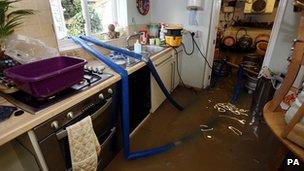UK floods: How can you protect your home or business?
- Published

People, on average, have to wait up to nine months before they can return to their flood-damaged homes
More than five-and-a-half million properties in England and Wales are deemed to be at risk from flooding.
This year has seen most parts of the UK being affected, with thousands of properties being flooded.
Despite efforts to improve and strengthen community flood defence schemes, many homes and businesses remain vulnerable.

The Environment Agency acknowledges that it is impossible to completely flood-proof a property, but there are a number of measures to prevent flood-water getting in and limit the damage.
What parts of my home are the weak-points that will allow flood-water into the property?
There are a number of routes in which floodwater can enter a property.
As well as coming through doors and patios, water can find its way in through air bricks on exposed walls and through gaps in the floor.
Another way is via through drains and pipes as the pressure created by flooding can reverse the flow, causing water to back-up and enter a home through sinks, toilets, washing machines etc.
What can I do to prevent or limit the amount of water entering my property?
The Environment Agency lists two ways that homes and businesses can protect properties: "flood resistance" measures, and making a building "flood resilient".
The BBC's Bob Walker visits a research centre to see how flood protection products are tested
Flood resistance refers to preventing water from entering in the first place.
The traditional methods of using sandbags can help for short periods when used in conjunction with plastic sheeting, and they can prevent contaminated mud and silt from entering a property.
But they do allow water to seep through and are not as effective as purpose-designed flood products.
There are a range of products on the market that are designed to offer protection.
These include:
Guards that can be quickly fitted when flooding is imminent. These can stop water from seeping through gaps in external doors, such as front and patio doors
Covers that can be fitted over ventilation bricks
"Non-return" values fitted to drain-pipes and other pipes that could allow water to back-up during a flood
Raising damp-proof courses and sealing floors

More than one million people have signed up to the Environment Agency's flood warning service
Flood protection experts recommend that people buy products that have been awarded a kitemark, as this means that the product has undergone a series of tests to ensure it is fit for purpose.
If a product is awarded a kitemark, it means that it meets the requirements outlined in PAS-1188 - a quality benchmark developed by the British Standards Institution (BSI), the Environment Agency and other partners.
The benchmark covers a range of product types, including removable products that act as barriers across vulnerable points, such as doors and airbricks; temporary, freestanding barriers which are assembled close to, but not in contact with, a building; and property flood skirt systems.
As well as fitting flood protection measures to your home, another measure is landscaping your garden in a way that helps divert water away from your property.
What can I do to limit the damage caused by flood water?
It is impossible to guarantee that flood-water will not enter your property, even if you have taken steps to protect your property.
The Environment Agency lists a number of ways to make your home "flood resilient", which will limit the damage and allow residents to return to their property quickly (on average, people are unable to live in their homes for nine months after being flooded).
These include:
Raising electrical sockets, fuse boxes and wiring to at least 1.5m (5ft) above floor level
In kitchens and bathrooms, use water-resistant materials, such as stainless steel, plastic or solid wood rather than chipboard
Use tiled flooring with rugs, rather than fitted carpets
Fix TVs and other electrical entertainment devices to the wall at least 1.5m off the floor
Put valuable or irreplaceable items on high-mounted shelves
How much will it cost to flood-proof my home?
This will depend on the size of your property and the level of flood resistance and resilience you require.
Figures from the Association of British Insurers (ABI) estimate that protecting a property against shallow flash floods will cost in the region of £2,000-£6,000.
However, protection against prolonged flooding requires bigger changes and could cost up to £40,000.
But the Environment Agency says taking measures to protect your property will limit the distress and damage caused by flooding, reduce the level of repairs and will allow you to return to your home or business more quickly.
Where can I get more information?
As an estimated one-in-six homes are located within at-risk areas, more than one million people have signed up to the Environment Agency's flood warning service, external.
As well as its flood warning service, the Agency has a section on its website that offers practical advice on how people can protect their homes and businesses from flooding, external, including an interactive guide on ways to reduce flood damage, external.
It also offers advice on how to develop a "flood plan, external" and what you and your neighbours need to do once a flood warning has been issued for your area.
The National Flood Forum, external, a charity that is dedicated to representing people living in areas at risk from flooding, has produced the "blue pages", which is an independent directory of flood protection products., external
- Published26 November 2012
- Published26 November 2012